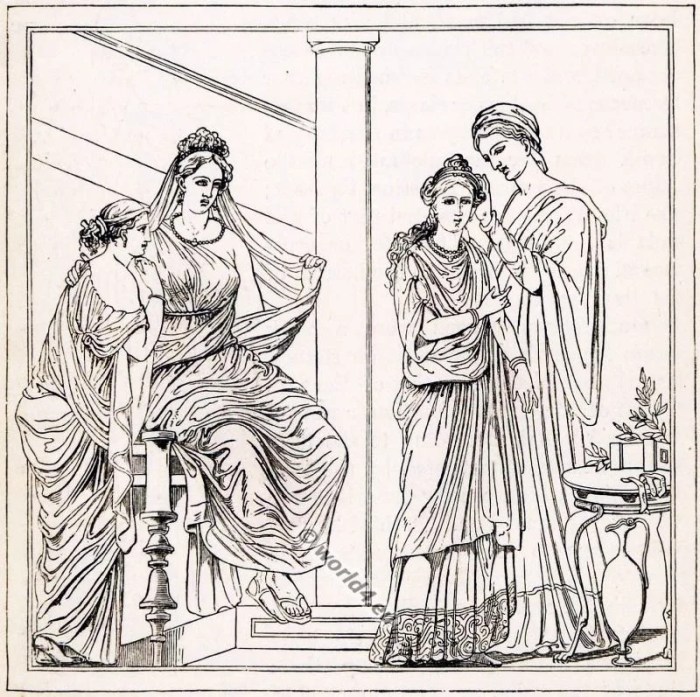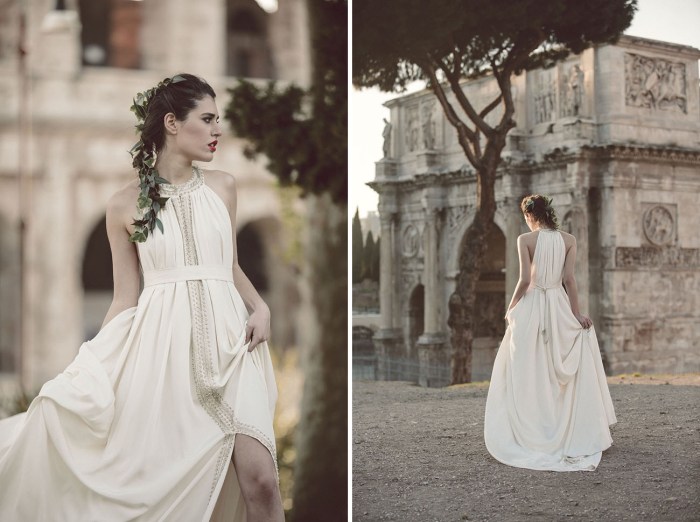Roman Goddess Wedding Dress A Modern Design
Historical Context of Roman Goddesses and Their Attire
Roman goddess wedding dress – Roman goddesses, powerful figures in mythology and religious life, were depicted in a variety of garments reflecting their roles and the era’s artistic styles. The fabrics, colors, and overall styles evolved over centuries, carrying symbolic weight and conveying their divine attributes.
Typical Attire of Roman Goddesses Across Eras
Early representations of Roman goddesses, often influenced by Greek prototypes, showed them in flowing
-chitons*, simple draped garments. Later, during the Roman Empire’s height, more elaborate attire emerged, including stolas (longer, sleeved tunics) and pallae (rectangular shawls or cloaks). The level of ornamentation varied; some goddesses were shown in simpler garments emphasizing their purity, while others were adorned with rich fabrics and jewelry to reflect their power and majesty.
The flowing elegance of a Roman goddess wedding dress, often depicted in flowing fabrics and simple adornment, contrasts sharply with the intricate detail of other eras. Consider, for instance, the sheer craftsmanship involved in the queen elizabeth wedding dress embroidery , a stunning example of meticulous needlework. This highlights how diverse and culturally significant wedding attire can be, even when compared to the seemingly simpler aesthetic of the Roman goddess style.
For example, Juno, queen of the gods, was often depicted in opulent robes, while Vesta, goddess of the hearth, was usually shown in simpler, more modest attire.
Symbolism in Fabrics and Colors
The fabrics and colors used in Roman goddess attire held significant symbolic meaning. Purple, a dye derived from shellfish, was associated with royalty and divinity, often reserved for depictions of Juno and other powerful goddesses. White symbolized purity and innocence, frequently seen in representations of Vesta and other virgin goddesses. Gold thread embroidery and luxurious fabrics like silk (imported from the East) indicated wealth and power, often associated with goddesses of abundance or victory.
Evolution of Roman Goddess Attire
The depiction of Roman goddesses’ clothing evolved from the simpler, more classical styles of the Republic to the increasingly elaborate and ornate styles of the Empire. Early representations emphasized the natural form, with garments flowing gracefully. Later depictions showed a greater use of elaborate jewelry, intricate embroidery, and richer fabrics, reflecting the increasing opulence of Roman society. The influence of Hellenistic art is evident in the earlier representations, while later depictions reflect Roman artistic preferences and the changing social and political landscape.
Interpreting “Wedding Dress” in a Roman Goddess Context: Roman Goddess Wedding Dress
Defining a “wedding dress” in the context of Roman mythology requires considering the nature of marriage and religious practices. While there weren’t formal wedding dresses in the modern sense, certain garments and rituals held symbolic significance related to marriage and union.
Roman Goddesses’ Attire in Marriage Ceremonies

Source: world4.eu
Roman goddesses, being immortal, didn’t participate in human-style marriage ceremonies. However, their attire in depictions often reflected concepts associated with marriage, such as fertility, prosperity, and union. For instance, Juno, goddess of marriage, was often shown in garments that symbolized these qualities. The absence of specific “wedding attire” for goddesses doesn’t negate the symbolic resonance of their clothing in relation to marital themes.
Comparing Goddess and Mortal Bride Attire
Mortal Roman brides typically wore a
-stola*, a long tunic, often white or saffron-colored, to signify purity and fertility. Their veils symbolized modesty and protection. While goddesses were not depicted in identical attire, the stola’s prevalence in both contexts suggests a shared symbolism of marital status and social standing. The key difference lies in the opulence and embellishments; mortal brides’ attire was generally simpler than the lavish garments often associated with powerful goddesses.
Designing a Modern “Roman Goddess Wedding Dress”
This section details the design of a modern wedding dress inspired by Juno, queen of the gods, known for her regal bearing and association with marriage and childbirth.
Juno-Inspired Wedding Dress Design
The design draws inspiration from Juno’s traditional representations, emphasizing grandeur and regal elegance. The color palette, silhouette, and embellishments are chosen to reflect her attributes and symbolic significance.
| Element | Description | Material | Symbolism |
|---|---|---|---|
| Silhouette | A-line gown with a fitted bodice and flowing skirt | Heavy silk satin | Emphasizes both regal bearing and fertility |
| Bodice | Structured bodice with a high neckline and long sleeves | Silk satin with gold embroidery | Represents Juno’s authority and power |
| Skirt | Full, flowing skirt with a subtle train | Layers of silk chiffon | Symbolizes abundance and fertility |
| Embellishments | Gold embroidery, pearl accents, and a jeweled belt | Gold thread, pearls, and Swarovski crystals | Represents wealth, power, and divine status |
| Veil | Long, flowing veil with delicate embroidery | Silk tulle with gold embroidery | Represents purity, modesty, and protection |
Symbolic Elements in a Roman Goddess Inspired Wedding Dress
Three key symbolic elements—the peacock feather, the pomegranate, and the laurel wreath—can be subtly incorporated into a modern Roman goddess-inspired wedding dress to enhance its aesthetic and thematic depth.
Symbolic Element Integration, Roman goddess wedding dress
Peacock feathers, symbolizing immortality and beauty, could be embroidered subtly into the train or used as delicate appliqués on the bodice. Pomegranates, representing fertility and abundance, could be depicted as small, jeweled embellishments on the belt or scattered delicately along the hemline. Finally, laurel wreaths, symbolizing victory and triumph, could be subtly incorporated into the hairpiece or as a motif on the veil.
Modern Interpretations of Roman Goddess Attire in Fashion
Elements of Roman goddess attire, such as draped fabrics, flowing silhouettes, and opulent embellishments, have consistently influenced modern wedding dress design. Many contemporary designers draw inspiration from ancient Roman styles to create elegant and timeless gowns.
Influence of Roman Styles on Modern Gowns
The flowing lines of the
-chiton* and
-stola* are frequently adapted in modern gowns, creating a sense of graceful movement and fluidity. The use of luxurious fabrics like silk and satin, along with intricate embroidery and beading, echoes the opulence of Roman goddess attire. The incorporation of symbolic elements, such as laurel wreaths or pomegranate motifs, adds a layer of historical and mythological depth to the design.
Illustrative Description of a Roman Goddess Wedding Dress

Source: greenweddingshoes.com
Imagine a wedding dress inspired by Juno, crafted from heavy silk satin in a deep ivory shade. The A-line silhouette flows gracefully from a fitted bodice, adorned with delicate gold embroidery depicting stylized peacock feathers. The full skirt ripples with each movement, hinting at the weight and richness of the fabric. A jeweled belt, shimmering with pearls and crystals, cinches the waist, accentuating the bride’s form.
The long, flowing veil, embroidered with a delicate pattern of laurel leaves, cascades behind her, creating an aura of regal elegance and timeless beauty. The overall impression is one of majestic grace, a perfect blend of ancient symbolism and modern sophistication. The tactile richness of the silk, the cool weight of the jewels, and the subtle shimmer of the gold embroidery create a sensory experience that is both luxurious and unforgettable.
Quick FAQs
What specific Roman goddess would be best to base a wedding dress design on?
The best goddess depends on the bride’s personality and desired aesthetic. Juno represents marriage and power, Venus embodies love and beauty, and Minerva symbolizes wisdom and strategy.
What modern fabrics would best emulate Roman fabrics?
Luxurious silks, flowing chiffons, and heavy brocades can effectively mimic the rich textures of Roman garments. Linen would be a good choice for a more historically accurate feel.
How can I incorporate subtle Roman symbolism without being overly literal?
Subtle integration can be achieved through embroidery, beading, or the use of specific colors associated with the chosen goddess. For example, incorporating laurel leaves (associated with victory) into the design would be a subtle yet impactful choice.
Are there any modern designers who have already incorporated Roman elements into their bridal collections?
Many high-fashion designers have drawn inspiration from classical antiquity, including elements of Roman design. Researching high-fashion bridal collections will reveal several examples.



















